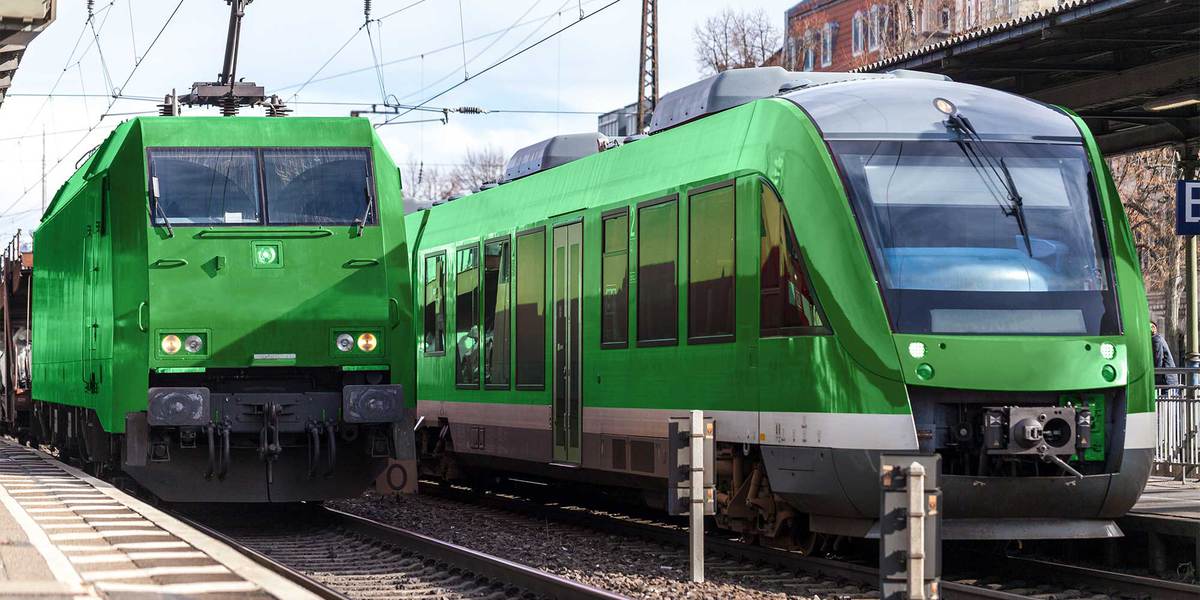On January 1, 2021, the European Year of Rail began. It was proposed by the European Commission back in March 2020 and approved by Parliament and the European Council in December 2020.
The project provides for the organization of events and other initiatives with the aim of raising public awareness on the cross-border European dimension of rail transport, in order to increase the share of people and goods traveling by train and enhance the contribution and support of rail to the economy, industry and the whole of European society.
As can be seen from the press release of the European Council, the project aims to underline and demonstrate the characteristics of sustainability, innovation and safety of rail transport, whose strategic role was recently confirmed during the COVID-19 pandemic, in which the logistics and transport sector overcame enormous operational and organizational difficulties, in guaranteeing the maintenance of essential connection services at both national and pan-European level.
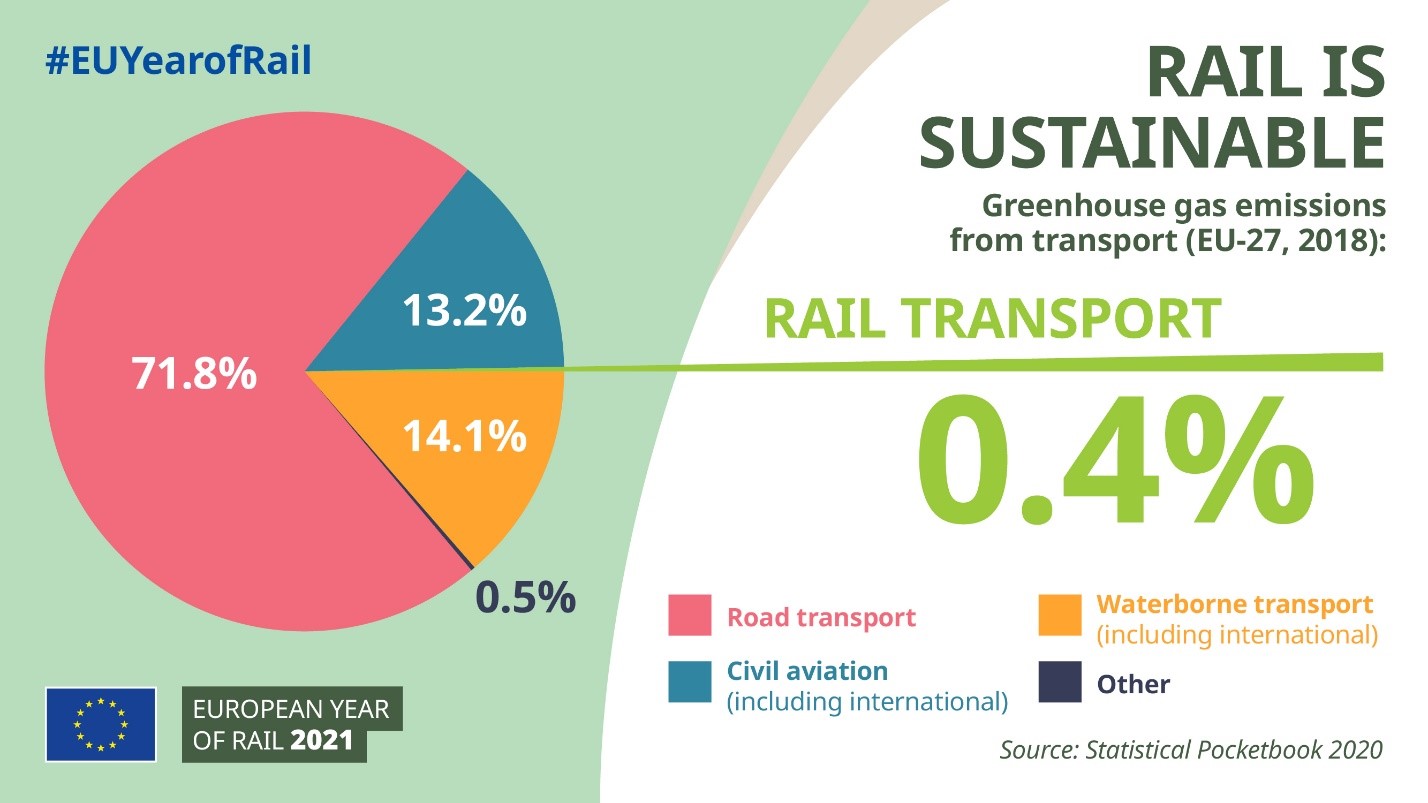
The European Year of Railways and European initiatives to support rail transport
Over the past 25 years, the European Commission has been very active in promoting the restructuring of the European rail transport market and in strengthening the positioning of the railway vis-à-vis other modes of transport.
One of the most recent initiatives, together with the inauguration of the European Year of Rail, is the adoption of the Sustainable and Smart Mobility Strategy. The strategy, presented by the Commission in December 2020, outlines the path towards greater sustainability and smart and resilient mobility, setting ambitious goals to be achieved by 2030 and 2050.
According to the action plan, high-speed rail traffic will have to double throughout Europe by 2030, while rail freight traffic will have to double by 2050, thanks to the achievement of the full operation of the Trans-European Transport network (TEN- T).
2021 marks another turning point, being also the first full year of EU-wide application of the rules and regulations agreed under the fourth Railway Package. The railway package is a set of legislative texts designed to complete the Single European Railway Area, the overall aim of which is to revitalize the railway sector and make it more competitive compared to other modes of transport.
The European Year of the Rail therefore fits perfectly into the broader European strategy for the transition towards a clean, digital and innovative economy, contributing to the achievement of the objectives defined by the European Green Deal, the plan to make the European economy sustainable and carbon-neutral by 2050.
Specifically, one of the objectives on which the European Year of Rail was established was targeting a reduction of 90% of transport emissions by 2050, through the spread of cleaner and more sustainable means and modes of transport.
As stated in a note from the European Commission, the transport sector is in fact responsible for approximately 25% of the EU's greenhouse gas emissions, of which less than 0.5% is attributable to the railways.
In addition to being one of the most sustainable modes of transport from an environmental point of view, rail can reduce road congestion leading to fewer related accidents and respiratory problems related to poor air quality and pollution, whilst offering an effective and efficient movement of a large number of people and goods across Europe.
However, despite these advantages, surprisingly only 7% of people and 13% of goods travel by train. These numbers are still too low, but offer enormous potential for growth and development, in line with the objectives of the European Union and the spirit of our times.
Results and trends of the European railway market
On January 13th, 2021, the Commission published its 7th report on the development of the rail market, which is presented every two years to the European Parliament and the Council under Directive 2012/34 / EU (recast of the first railway package).
The rail market monitoring report provides an overview of key developments and trends in EU rail markets, as well as on individual member countries.
This report takes into consideration the countries of the EU-27 and refers to the period 2015-2018, and is therefore not affected by the impact of the COVID-19 pandemic on the sector.
Here are some of the main results and trends that emerged from the Report, in terms of sustainability and consumption, length of the railway network, railway traffic and performance of the railway infrastructure.
Train and sustainability
The train is the only type of transport to have almost continuously reduced its emissions of greenhouse gases and CO2 since 1990. In 2018, the railway transported 13% of goods and 7% of passengers, however it accounted for only 0.4% of greenhouse gas and CO2 emissions and 2% of energy consumption of the entire transport sector in the EU27.
The railway is therefore confirmed to be relatively less polluting and more efficient from an energy point of view, compared to other motorized means of transport.
Railway network
The total length of the EU27 rail network in 2018 was approximately 201,000 kilometers (2,000 km less than in the United States and 69,000 km more than China), a decrease of 0.4% compared to 2015. In 2018, approximately 56% of the network was electrified, with an increase of 855 kilometers from 2015 (+ 1.2%).
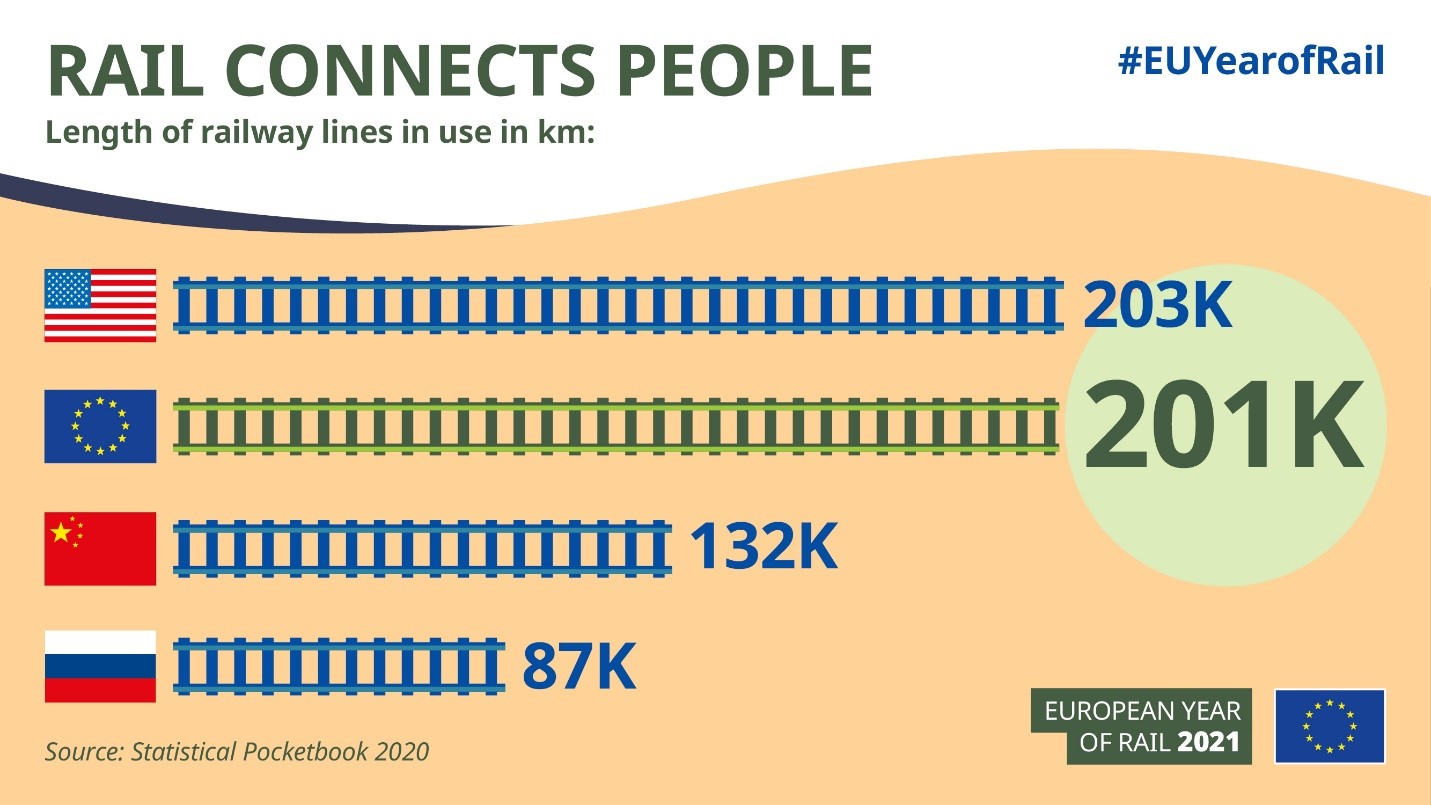
It is interesting to note that, within the EU-27, Italy ranks 4th for length of the railway network, behind Germany, France, and Poland, with over 16,000 kilometers of railways, slightly down compared to the previous year 2015.
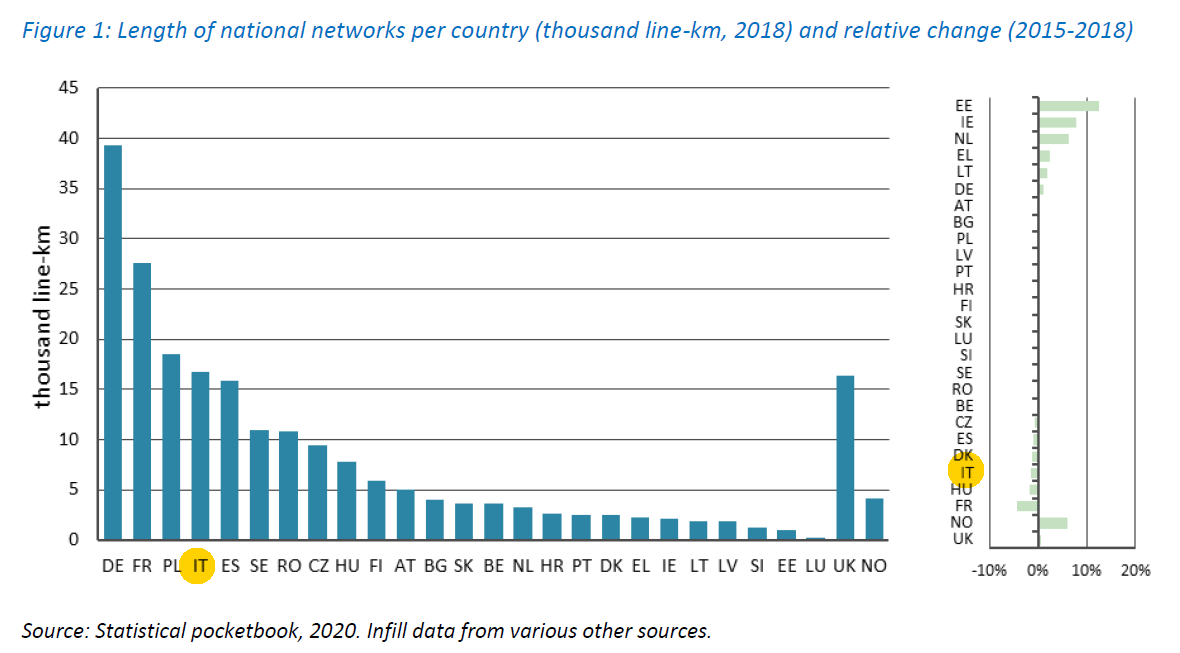
Rail traffic
Between 2015 and 2018, rail traffic in the EU27 increased annually by 2.5% for passengers and 4.1% for freight.
In 2018, EU27 rail freight volumes accounted for 435 billion tonne-kilometers out of 2.3 trillion tonne-kilometers of total land transport. More than half of the total rail freight transport is cross-border, which makes the competitiveness of rail transport very sensitive to interoperability and operational challenges between national rail networks.
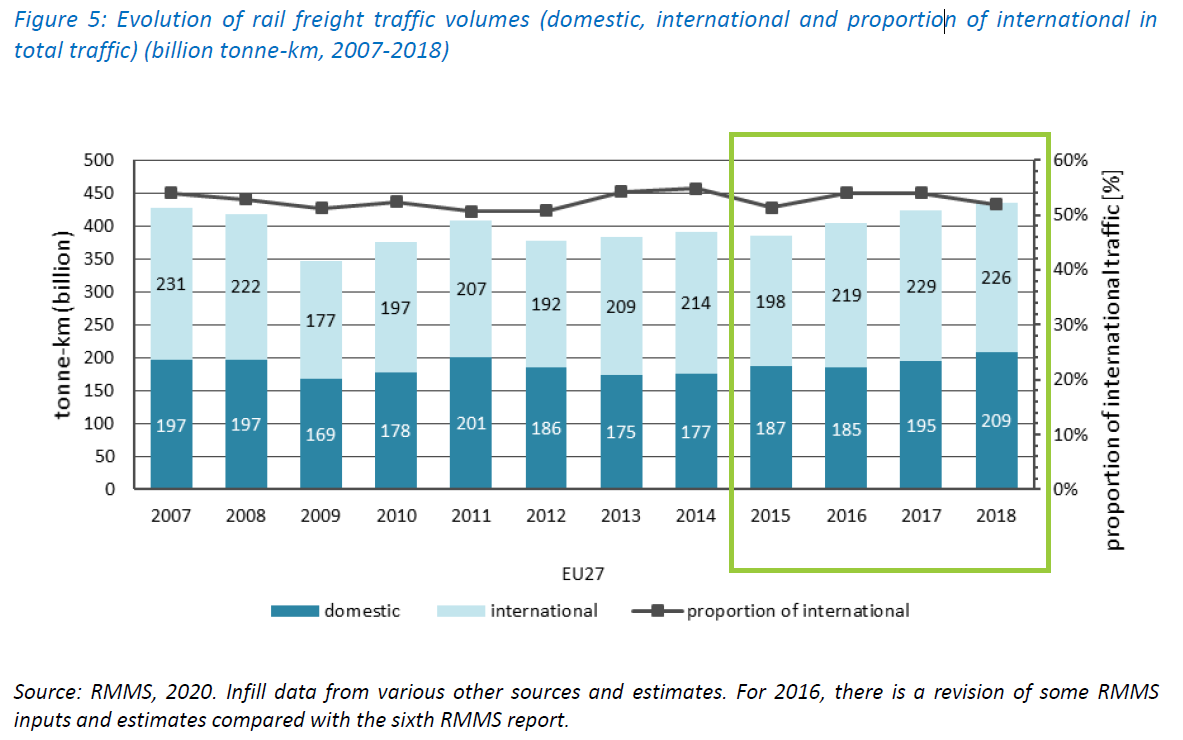
Between 2015 and 2018, the modal share of rail in inland freight transport in the EU27 decreased from 18.8% to 18.7%, in favour of road transport, with significant differences between countries.
Italy, despite its long railway network, ranks in 15th position for the modal share of rail in freight transport, which is worth about 12% of the total, a slight decrease compared to 2015.
This figure reflects the limits of the Italian railway infrastructure and the growth potential of the service offer. The removal of bottlenecks and operational limitations (linked for example to the adaptation of the tunnels necessary to increase the size limit and allow the use of high capacity load units, such as the P400 trailers) represents, together with the development of intangible infrastructures and technologies for collecting and sharing data in real time, one of the cornerstones on which to build the future of the Italian railway system.
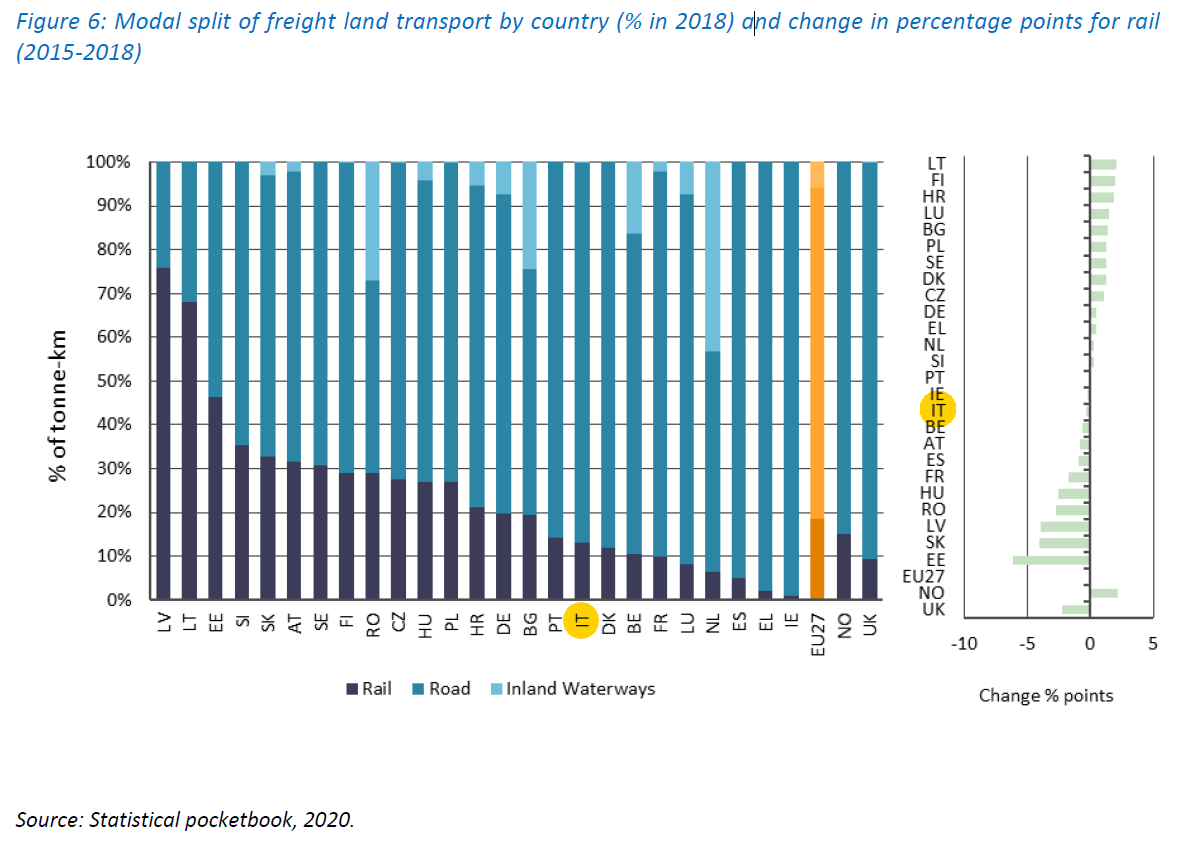
Performance in the railway infrastructure
In 2018, the EU27 network showed an intensity of use of 18,200 train-kilometers per kilometer of line. The most used networks in 2018 were those of Western Europe, in particular the Netherlands, with an intensity of use of 50.6 thousand train kilometers per kilometer of line. On the opposite side we find Greece, with only 4.8 thousand kilometers of train per kilometer of line.
Total track length declared congested in the EU27 has steadily increased since 2015 and nearly doubled in 2018.
The average punctuality in 2018 for rail freight in the EU27 was 60% for domestic services and 53.2% for international services. Furthermore, 7.3% of domestic services and 11% of international services were cancelled.
The 7th report on the development of the rail market concludes by proposing four fundamental objectives to support the growth of the railway sector:
-
Create a fair and competitive market for all operators and allow the introduction of new multimodal offerings creating greater choice for passengers and businesses.
-
Improve cross-border rail services to increase the modal share of rail transport by facilitating the process of crossing the EU's internal borders.
-
To improve the performance of the railway infrastructure to ensure the efficient provision of rail transport services.
-
Improving punctuality, reliability, and access to services in railway structures for both passenger and freight services, in order to meet customer needs more efficiently.
transport
The railway sector makes a substantial contribution to the European economy, directly employing more than 900,000 people and moving around 1.6 billion tons of goods and 7.1 billion passengers every year.
The increased use of rail is key to meeting the need for a more sustainable transport sector and will drive positive effects on reducing pollution and energy consumption, helping to achieve the ambitious targets for cuts in emissions set out in the European Green Deal.
The Contship Italia Group, through its intermodal subsidiaries and the strategic choices made in its terminals in Ravenna (Terminal Container Ravenna) and La Spezia (La Spezia Container Terminal), continues to strongly believe in the development of the Italian and European railway network and in the use of the train as the preferred mode for land transport, an approach that is reflected in the ambitious development goals, which focuses precisely on the train, to renew and further characterize the Group's integrated logistics offer.

